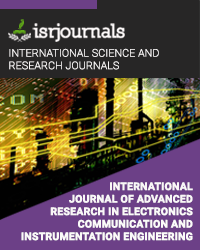algorithm for reduced complexity and high performance embedded mimo receivers
D.JESLINE ANTONIO,,ALLAN J WILSON,
Published in International Journal of Advanced Research in Electronics, Communication & Instrumentation Engineering and Development
ISSN: 2347 -7210 Impact Factor:1.9 Volume:1 Issue:1 Year: 08 November,2013 Pages:4-11

Abstract
Matrix inversion is a key enabling technology in MIMO (Multi Input Multi Output) communication systems. To date, no matrix inversion implementation has been devised which supports real-time operation for these standards. In this, we overcome this barrier by presenting a novel matrix inversion algorithm which is ideally suited to high performance floating-point implementation. Specifically, we present a matrix inversion approach based on modified squared Givens rotations (MSGR). This is a new QR decomposition algorithm which overcomes critical limitations in other QR algorithms that prohibits their application to MIMO systems. In addition, we present a novel modification that further reduces the complexity of MSGR by almost 20%. This enables real-time implementation with negligible reduction in the accuracy of the inversion operation, or the BER of a MIMO receiver based on this.
Kewords
BLAST, matrix inversion, multiple input multiple output (MIMO), QR decomposition
Reference
1] G. Foschini, “Layered space-time architecture for wireless communication in a fading environment when using multi-element antennas,”Bell Lab. Tech. J., pp. 41–59, 1996. [2] P. Wolniansky, G. J. Foschini, G. D. Golden, and R. A. Valenzuela, “V-BLAST: An architecture for realizing very high data rates over the rich-scattering wireless channel,” in Proc. URSI Int. Symp. Signals, Syst., Electron., 1998, pp. 295–300. [3] M. Sellathurai and S. Haykin, “Turbo-blast for wireless communications: Theory and experiments,” Bell Lab. Tech. J., vol. 50, pp. 2538–2546, 2002. [4] F. Echman and V. Owall, “A scalable pipelined complex valued matrix inversion architecture,” in Proc. IEEE Int. Symp. Circuits Syst. (ISCAS 2005), May 2005, pp. 4489–4492. [5] I. LaRoche and S. Roy, “An efficient regular matrix inversion circuit architecture for MIMO processing,” in Proc. IEEE Int. Symp. Circuits Syst. (ISCAS 2006), May 2006, pp. 4819–4822. [6] M. Myllyla, J.-H. Hintikka, J. Cavallaro, M. Juntti, M. Limingoja, and A. Byman, “Complexity analysis of MMSE detector architectures for MIMO OFDM systems,” in Conf. Rec. 39th Asilomar Conf. Signals, Syst., Comput. (2005), vol. 1, pp. 75–81. [7] M. Karkooti, J. Cavallaro, and C. Dick, “FPGA implementation of matrix inversion using QRD-RLS algorithm,” in Conf. Rec. Asilomar Conf. Signals, Syst. Comput., 2005, pp. 1625–1629. [8] H. S. Kim, W. Zhu, J. Bhatia, K. Mohammed, A. Shah, and B. Daneshrad, “A practical, hardware friendly MMSE detector for MIMO-OFDM-based systems,” EURASIP J. Adv. Signal Process., vol. 2008, pp. 1–14, Jan. 2008. [9] M. Ylinen, A. Burian, and J. Takala, “Updating matrix inverse in fixed-point representation: Direct versus iterative methods,” in Proc. Int. Symp. Systemon- Chip, 2003, pp. 45–48. International Journal of Advanced Research in Electronics, Communication and Instrumentation Engineering and Development Volume-1: Issue-1 November 2013 ISR Journals and Publications Page 8 [10] S. Haykin, Adaptive Filter Theory. Englewood Cliffs, NJ: Prentice- Hall, 1991. [11] G. Lightbody, R.Walke, R.Woods, and J. McCanny, “Linear QR architecture for a single chip adaptive beamformer,” J. VLSI Signal Process. Syst. Signal, Image, and Video Technol., vol. 24, pp. 67– 81, 2000. [12] Z. Liu, J. McCanny, and R. Walke, “Generic Soc QR array processor for adaptive beamforming,” IEEE Trans. Circuits Syst., Part II—Analog Digit. Signal Process., vol. 50, no. 4, pp. 169–175, Apr. 2003. [13] R. Hamill, J. McCanny, and R. Walke, “On-line CORDIC algorithm and VLSI architecture for implementing QR-array processors,” IEEE Trans. Signal Process., vol. 48, no. 2, pp. 592–598, Feb. 2000. [14] W. Givens, “Computation of plane unitary rotations transforming a general matrix to triangular form,” J. Soc. Indust. Appl. Math, vol. 6, pp. 26–50, 1958. [15] G. Golub, “Numerical methods for solving leastsquares problems,” Num. Math., vol. 7, pp. 206–216, 1965. [16] R. Dohler, “Squared givens rotations,” IMA J. Numer. Anal.,

